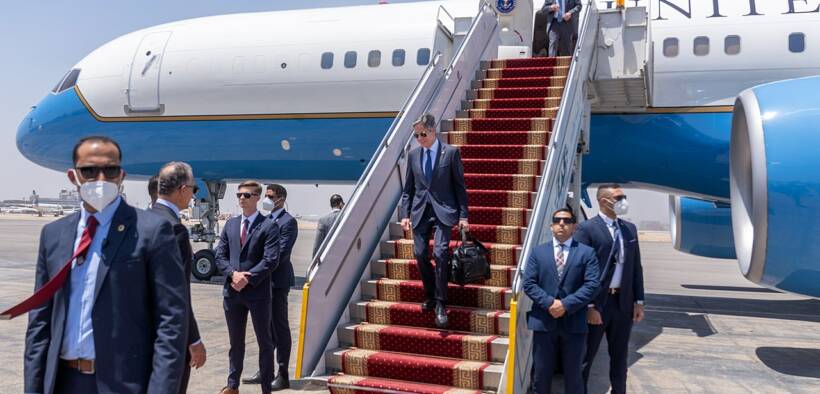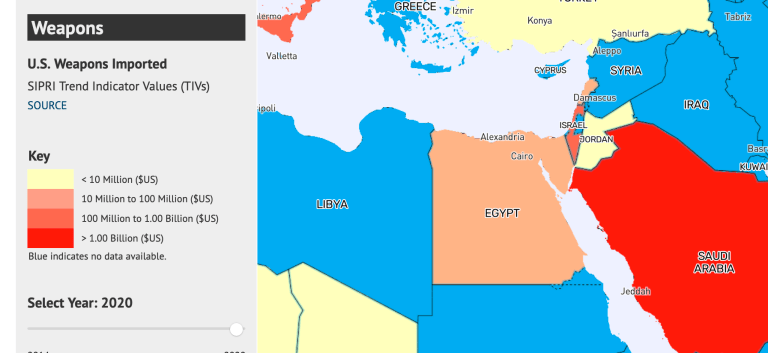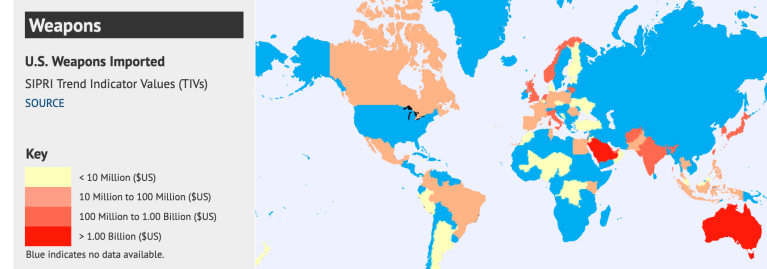Biden’s Budget Proposal Funds Most of the World’s Dictators

There’s nothing new about this, which is why I know it’s there before having seen the new budget proposal. The United States funds most of the world’s most oppressive militaries, sells them weapons, and trains them. It has done so for many years. But if you’re going to propose an enourmous budget that relies on deficit spending, and you’re going to claim that a gargantuan military budget (bigger than the Vietnam War budget that derailed LBJ’s domestic priorities) is somehow justified, then I think you ought to have to stand and justify every bit of it, including the 40% or so of U.S. foreign “aid” that’s actually money for weapons and militaries — first and foremost for Israel.
A U.S.-government-funded source for a list of the oppressive governments of the world is Freedom House, which ranks nations as “free,” “partly free,” and “not free.” These rankings are supposedly based on civil liberties and political rights within a country, with apparently no consideration of a country’s impact on the rest of the world.
Freedom House deems the following 50 countries (taking from Freedom House’s list only countries and not territories) to be “not free”: Afghanistan, Algeria, Angola, Azerbaijan, Bahrain, Belarus, Brunei, Burundi, Cambodia, Cameroon, Central African Republic, Chad, China, Democratic Republic of Congo (Kinshasa), Republic of Congo (Brazzaville), Cuba, Djibouti, Egypt, Equatorial Guinea, Eritrea, Eswatini, Ethiopia, Gabon, Iran, Iraq, Kazakhstan, Laos, Libya, Mauritania, Nicaragua, North Korea, Oman, Qatar, Russia, Rwanda, Saudi Arabia, Somalia, South Sudan, Sudan, Syria, Tajikistan, Thailand, Turkey, Turkmenistan, Uganda, United Arab Emirates, Uzbekistan, Venezuela, Vietnam, Yemen.
The U.S. government allows, arranges for, or in some cases even provides the funding for, U.S. weapons sales to 41 of these countries. That’s 82 percent. To produce this figure, I have looked at U.S. weapons sales between 2010 and 2019 as documented by either the Stockholm International Peace Research Institute Arms Trade Database, or by the U.S. military in a document titled “Foreign Military Sales, Foreign Military Construction Sales And Other Security Cooperation Historical Facts: As of September 30, 2017.” Here are the 41: Afghanistan, Algeria, Angola, Azerbaijan, Bahrain, Brunei, Burundi, Cambodia, Cameroon, Central African Republic, Chad, China, Democratic Republic of Congo (Kinshasa), Republic of Congo (Brazzaville), Djibouti, Egypt, Equatorial Guinea, Eritrea, Eswatini (formerly Swaziland), Ethiopia, Gabon, Iraq, Kazakhstan, Libya, Mauritania, Nicaragua, Oman, Qatar, Rwanda, Saudi Arabia, Sudan, Syria, Tajikistan, Thailand, Turkey, Turkmenistan, Uganda, United Arab Emirates, Uzbekistan, Vietnam, Yemen.
These graphics are screenshots from a mapping tool called Mapping Militarism.
Of the nine “not free” nations to which the United States is not shipping weapons, the majority of them (Cuba, Iran, North Korea, Russia, and Venezuela) are nations commonly designated as enemies by the U.S. government, offered as justifications for budget increases by the Pentagon, demonized by the U.S. media, and targeted with significant sanctions (and in some cases attempted coups and threats of war). These countries’ status as designated enemies also, in the view of some critics of Freedom House, has a lot to do with how some of them got onto the list of “not free” rather than “partly free” nations. Similar logic could explain the absence of some countries, such as Israel, from the “not free” list.
China may be the “enemy” you hear the most about from the U.S. government, but the U.S. government still collaborates with China, not only on bioweapons labs but also by allowing U.S. companies to sell it weapons.
Now, let’s take the list of 50 oppressive governments and check which ones the United States government provides military training to. There are varying levels of such support, ranging from teaching a single course for four students to providing numerous courses for thousands of trainees. The United States provides military training of one sort or another to 44 out of 50, or 88 percent. I base this on finding such trainings listed in either 2017 or 2018 in one or both of these sources: The U.S. State Department’s Foreign Military Training Report: Fiscal Years 2017 and 2018: Joint Report to Congress Volumes I and II, and the United States Agency for International Development (USAID)’s Congressional Budget Justification: FOREIGN ASSISTANCE: SUPPLEMENTARY TABLES: Fiscal Year 2018. Here are the 44: Afghanistan, Algeria, Angola, Azerbaijan, Bahrain, Belarus, Brunei, Burundi, Cambodia, Cameroon, Central African Republic, Chad, China, Democratic Republic of Congo (Kinshasa), Republic of Congo (Brazzaville), Djibouti, Egypt, Eswatini (formerly Swaziland), Ethiopia, Gabon, Iran, Iraq, Kazakhstan, Laos, Libya, Mauritania, Nicaragua, Oman, Qatar, Russia, Rwanda, Saudi Arabia, Somalia, South Sudan, Tajikistan, Thailand, Turkey, Turkmenistan, Uganda, United Arab Emirates, Uzbekistan, Venezuela, Vietnam, Yemen.
Now let’s take one more run through the list of 50 oppressive governments, because in addition to selling them weapons and training them, the U.S. government also provides funding directly to foreign militaries. Of the 50 oppressive governments, as listed by Freedom House, 32 receive “foreign military financing” or other funding for military activities from the U.S. government, with — it’s extremely safe to say — less outrage in the U.S. media or from U.S. tax payers than we hear over providing food to people in the United States who are hungry. I base this list on the United States Agency for International Development (USAID)’s Congressional Budget Justification: FOREIGN ASSISTANCE: SUMMARY TABLES: Fiscal Year 2017, and Congressional Budget Justification: FOREIGN ASSISTANCE: SUPPLEMENTARY TABLES: Fiscal Year 2018. Here are the 33: Afghanistan, Algeria, Angola, Azerbaijan, Bahrain, Belarus, Cambodia, Central African Republic, China, Democratic Republic of Congo (Kinshasa), Djibouti, Egypt, Eswatini (formerly Swaziland), Ethiopia, Iraq, Kazakhstan, Laos, Libya, Mauritania, Oman, Saudi Arabia, Somalia, South Sudan, Sudan, Syria, Tajikistan, Thailand, Turkey, Turkmenistan, Uganda, Uzbekistan, Vietnam, Yemen.
These graphics are again screenshots from Mapping Militarism.
Out of 50 oppressive governments, the United States militarily supports in at least one of the three ways discussed above 48 of them or 96 percent, all but the tiny designated enemies of Cuba and North Korea. And this generosity by U.S. taxpayers extends well beyond 50 countries. Look at the last map above. There are very few white spots on it.
For more on this topic, see 20 Dictators Currently Supported by the U.S.



















